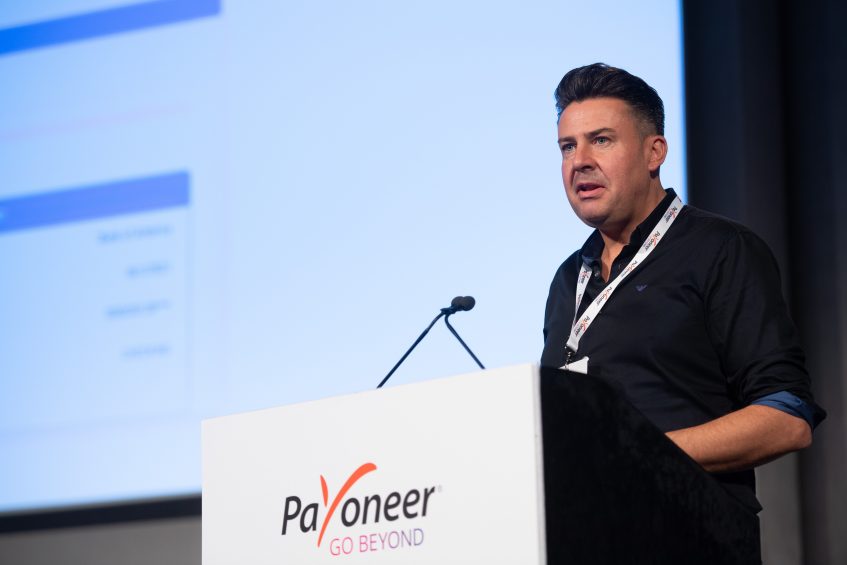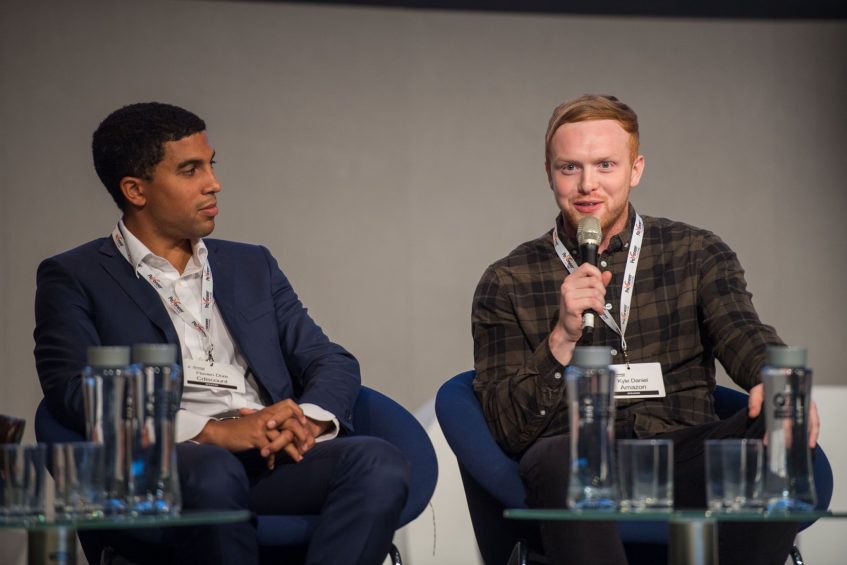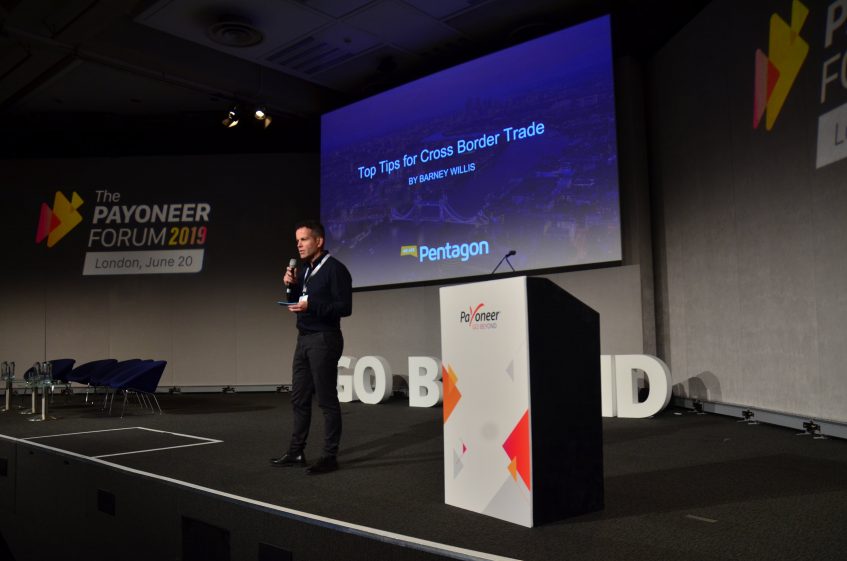
The A-Z For Sellers Going Global: Five Takeaways from Our London Forum
The $3 trillion eCommerce industry presents an infinite number of possibilities for sellers interested in taking their business global. That was the main lesson from the 2019 Payoneer London Forum, a day-long event featuring the biggest names in eCommerce and fintech discussing some of the most important global trends impacting the seller community.


Daniel Mayhew, Payoneer UK Country Manager
Following opening remarks from Payoneer VP of Marketing Jonny Steel, Payoneer’s UK Country Manager, Daniel Mayhew, discussed global eCommerce’s transformation over the years and how Payoneer is ideally positioned to assist sellers as they take their businesses cross-border. Specific points included:
- Payoneer in-network payments – With thousands of global customers being added to the Payoneer community every day, in-network payments gives you the opportunity to instantly pay other Payoneer users, including suppliers and vendors, for free.
- VAT payments – Easily pay VAT directly from your Payoneer balance, saving you time and money on FX rates.
- Capital Advance – For Amazon and Walmart sellers, working capital offers of up to 100% of your store’s monthly volume give you the ability to grow your business and further expand globally.
Then, speakers from Amazon, cDiscount, Mercado Libre, Avalara, Catch, Newegg, Rakuten and We Are Pentagon covered a number of important topics, such as the best ways to approach US sales tax, expand into Latin America and navigate the French eCommerce market. Here, we’ll present five key takeaways from the forum, including actionable insights that can be used as you expand your business and go global.
1. Selling in the US? Learn Where You Need to Pay Tax


Jake Estes, Solutions Engineer EMEA at Avalara
With more than $500 billion in physical eCommerce sales in 2018, breaking into the US market should be at the top of any seller’s to-do list when taking their business cross-border. Dealing with sales tax in the different states in which you’re operating, however, can be a complicated process.
In his talk about navigating US sales tax, Jake Estes, Solutions Engineer EMEA at Avalara, discussed the different parts of the tax code that sellers need to be aware of when they establish a presence in a given state. This can quickly become very tricky, as different states have different rules as to what constitutes an actual presence. For example:
- Affiliation – An affiliate in North Carolina driving traffic to your site triggers a tax obligation in North Carolina.
- Influencers – Using an influencer based in California to advertise your business triggers a tax obligation in California.
- Web cookies – In Massachusetts, leaving a web cookie on your users’ browsers triggers a tax obligation.
Other things to consider include distance selling thresholds, an ever-changing set of new state laws and regulations, consumer use tax and different retail sales taxes in different states for different product types. While this all sounds very complex, it should not discourage you from taking your business to the US. Companies like Avalara are available to help you navigate state and federal tax laws. If done properly, the benefits of selling in the US will likely far outweigh the headache of dealing with paying taxes there.
2. Latin America: A Growing eCommerce Giant


Jose Luis Hervás Fernández, Head of Cross-Border Trade at Mercado Libre
eCommerce in Latin America has a compound annual growth rate (CAGR) of 19%, a huge number that should be a wakeup call for sellers when planning your global expansion. That was the overall message given by Jose Luis Hervás Fernández, Head of Cross Border Trade at Mercado Libre, Latin America’s most popular eCommerce platform.
By describing the changing fundamentals in Latin America, including a significant social media presence as well as mobile device penetration, and a vastly improved shipping and delivery network, Fernández illustrated why the time is right to start selling in the region. Latin American populations in such countries as Mexico, Chile, Argentina, Colombia and Brazil are largely underserved when it comes to eCommerce, giving cross-border sellers an excellent opportunity to tap into still maturing markets.
3. Now’s the Time to Take Your Business to Australia


Kyle Daniel, Partner Associate at Amazon
A lot has happened in the world of Australian eCommerce in recent years. Gone are the days when it would take several weeks to receive a package shipped from the United States and there was little market penetration in the more remote areas of the country.
So, what’s changed? To put it simply, Amazon AU changed everything. Amazon’s expansion into Australia, which included the opening of several domestic fulfillment centers and an advanced delivery network has led to a major spike in eCommerce and has presented cross-border sellers with an excellent expansion opportunity.
In his presentation, Kyle Daniel, Partner Associate at Amazon, detailed some of the key considerations for anyone interested in taking their business to Australia, including Amazon AU’s fee structure, the benefits of using Fulfillment by Amazon (FBA) and getting your merchandise listed as a Prime product.
The good news for sellers already operating in Europe and North America is that because there are so many cultural similarities among the different populations, your existing listings and products can very easily transfer over to the Australian market.
Want to learn more about selling on Amazon AU? Have a look at our comprehensive guide.
4. If You Want to Succeed in Europe, You Must Sell in France


Flavien Dore, Head of B2B Services at Cdiscount
Are you a seller interested in breaking into the European market? According to Flavien Dore, Head of B2B Services at Cdiscount, there is only one place to start: France. With more than 40 million online shoppers, a whopping 85% of all internet users in the country, the French eCommerce market is rapidly maturing and reaching rural areas that were once largely underserved.
A large part of this expansion was due to Cdiscount and its creative solutions when it came time to target new demographics and geographic areas, including:
- Specialized services – Cdiscount provides a wide variety of specialized services beyond traditional eCommerce, including travel planning, health insurance and home care.
- Advanced logistics – Cdiscount has a nationwide network of pickup points that are especially helpful when servicing customers in rural areas of France.
For sellers interested in expanding to France, innovative platforms like Cdiscount provide you with a chance to reach beyond your typical customer base and tap into new populations.
5. If You Want to Go Global, Start Local


Barney Willis, Managing Director of Managed Partners at We Are Pentagon
If you want to go global, start by dominating your local market. For Barney Willis, Managing Director of Managed Partners at We Are Pentagon, this is the first thing every seller should do before expanding cross-border. While this might seem odd at first (why would you focus on your domestic market when trying to reach foreign customers?), according to Willis, it’s critical for several reasons:
- Master your business – Focusing on a population you’re familiar with gives you the ability to hone your business and establish a comfortable working model.
- Improve local SEO – 97% of people search for a product online before purchasing, meaning it’s imperative to have an SEO optimized store.
- Increase positive online reviews – Starting off in your local market allows you to establish a good customer service network, return policy and shipping procedure, which will likely lead to positive reviews for your store.
Other tips for cross-border sellers after they expand include building up a logistics infrastructure, maintaining customer transparency and having a clear-cut returns policy that focuses on customer experience. Lastly, Willis highlighted the need to adapt to foreign markets using accurate product translations, offering local customer support and staying attuned to accepted cultural norms.
Looking to the Future of Global eCommerce
For our last panel of the day, Paul Laidler, Head of Merchant Acquisition at Catch, Gareth Lloyd-Jones, Head of Europe Operations at Newegg and Romain Roy, Head of B2B Sales at Rakuten offered their input as to what the future holds for global eCommerce and how sellers need to adapt. Specific tips included:
- Stay eco-friendly – The current generation of buyers is very environmentally conscious, making it important to ensure that your products are eco-friendly.
- Keep up with new technology – New technology, including AI and advanced smart technology, are likely to continue dominating global sales. If possible, incorporate new technologies into your product line.
- Continuously optimize your store – Amid the growth in global eCommerce, getting your store noticed is critical for your success. Invest in SEO and mobile optimization, as well as paid advertising to increase your visibility and stay competitive.
As one of the leading cross-border payment platforms, Payoneer is here to assist as you take your business global. Our many services, including local currency accounts, VAT payment solution and Capital Advance, simplify your expansion by ensuring the payments component of your business is handled properly.




